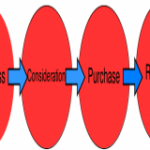Amidst all the conversation about content marketing, few seem to be talking about the importance of having a plan before hitting “publish”. While it’s better to be creating content than doing nothing at all, the real power in content marketing is in the strategy behind it.
Part of that strategy is taking the time to understand how your customers buy from you and progress through the buying cycle – then delivering content that helps to push them into the next stage of that cycle. The formats, messaging, calls-to-action and key performance indicators will differ at every stage, though there is certainly overlap.

1. Interest/Awareness
At this stage of the cycle, you’re aiming to earn permission to pitch yourself later on. No relationship or rapport has been established with your audience, so you’re essentially strangers.
Customers in this stage are looking to be entertained or engaged, not sold to. They may be aware of their need for your product or service, but have little reason to choose you over a competitor.
This is an opportunity to introduce your brand, your values and your brand personality – but it’s still all about the customer. The goal is to attract and engage, so SEO and inbound channels play a tremendous role.
Content Format Ideas: Blog posts, memes, entertaining video, guides, whitepapers, podcasts
CTAs: Calls-to-action should be invitations to engage, not to buy. Examples include:
“Share this!”, “Leave us a comment”, “Download our free resource”, “Subscribe to our channel/newsletter”, etc.
KPIs: Search engine rankings, visitors, comments, likes, shares, downloads, subscriptions, views
2. Consideration/Establishing Preference
In the consideration stage, customers have identified a need and are actively seeking out potential solutions. As they go along, they’re establishing their preferred provider. At this point, you play the role of a helpful, friendly guide.
It’s crucial to establish credibility, inform the customer with a benefit-first message and make the research process easier for them. Content should focus on the main points of your target market.
You need to prove you’re a worthy option and present reasons to choose you or switch from a competitor.
Content Format Ideas: Targeted landing pages (with competitor comparisons), spec sheets, demo videos, tutorials, case studies, “about us” page/brand stories, testimonials, reviews, whitepapers, eBooks, informational events
CTAs: Invitations to subscribe, take a free trial, learn more, watch a demonstration or attend an event would all be examples of slightly more direct calls to action that aim to build trust in your offering without insisting on an immediate buy.
KPIs: Subscriptions, trial sign-ups, downloads, event attendance
3. Purchase/Decision
Having evaluated their options, the lead is ready to make a purchase decision. At this point, content should be created to support, reinforce and alleviate the buyer’s aversion to risk. It’s all about building confidence in the fact that they’re making the right decision.
Messaging should revolve around the benefits of your product, the reliability of your service and your quality guarantee.
Content Format Ideas: Spec sheets, competitor analysis, demonstrations and tutorials, ROI calculators, direct response e-mails and landing pages, pricing information, reviews & testimonials, coupons and special offers
CTAs: Now is the time for the direct ask. “Buy now”, “Talk to an expert”, “Call today!” and “Place an Order” are all examples of direct calls-to-action that will drive the lead to become a customer.
KPIs: Sales, incoming calls, conversions
4. Evaluation & Repurchase
Your audience began as strangers, but at this stage they’ve become paying customers. The goal from here is to turn those customers into loyal customers and advocates.
At this point the aim is to follow-up, ensure satisfaction and encourage sharing with others. Keep in mind that the customer will repeat the buying cycle again the next time they need to make a purchase, so it’s critical that you keep in touch and reinforce your value across time.
Content Format Ideas: Feedback forms and surveys, special offers, promotional deals, newsletters, blog posts, members-only events
CTAs: “Give us your feedback”, “Send us a review”, “Recommend a friend”, “Share with others”, “Tell us your story”
KPIs: Referrals, repeat sales, number of reviews, submitted feedback
Align, Execute, Repeat
Don’t create content blindly. Instead, evaluate the average buying cycle of a customer and create targeted content for each stage that drives them to the end conversion – and beyond.
It’s a powerful, measurable, goal-orientated approach that won’t leave you wondering whether or not the things you’re creating are having an impact.




